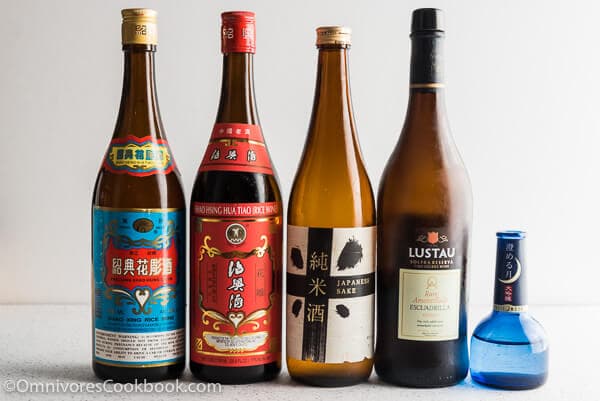
Lots of Chinese recipes uses alcohol to enhance flavor. When a recipe calls for cooking wine, it usually mean Shaoxing wine.
Shaoxing wine (绍兴黄酒, Shaoxing Huang Jiu) is a type of Huangjiu, literally means yellow wine. It is made from ferment rice, has a translucent amber color and with alcohol percentage of 14% – 20%. It has a mixed complicated flavor of sweet, bitter, sour and spicy, regarded as a popular beverage in China, especially for hot winter drink. It’s a crucial ingredients in cooking as well.
Cooking wine is often called in marinade. It’s also widely used in braising and stir fried dishes. By adding it into marinade, it can eliminate the raw smell of meat and infuse a nice flavor to the dish. Same logic to using red wine in cooking.
Alternatives
Sourcing a good Shaoxing wine without salt content can be tricky outside of China. In this case, do consider Japanese sake and dry sherry. Both do very well in Asian cooking and can result in a very similar flavor.
Generally speaking, dry sherry is closer to Shaoxing wine, only with a slight hint of sweetness. Japanese sake is more delicate and mild, and also has a sweet flavor. If you have both on hand, use dry sherry in pungent dishes (esp. spicy ones), and use sake to cook delicate dishes (such as dumpling filling, soup, etc.). We always have sake in the fridge, because we love to drink it, too!
You might able to use smaller amount of whiskey or Vodka in certain Asian dishes to replace cooking wine, but it will largely depend on the recipe itself. Use these alternatives only if you’re very familiar with Asian cooking.
Buy
Read the label before you purchase any Shaoxing wine. It should NOT contain salt. The US-branded Shaoxing wine often contains a very high salt content, because that’s the only way it can be sold in a shop without liquor restrictions. Do not get this type.
You might able to find the good Shaoxing wine at large Asian market, but unlikely if you live in a smaller city. In this case, visit liquor store or supermarket for sake or dry sherry.
Store
Once opened, Shaoxing wine and dry sherry can be stored in a cool, dark place for a few months. If you seldom use it, you should store it in the fridge. I always prefer to keep opened sake in the fridge, because it loses its delicate fragrant much faster than other cooking wine.













This was really helpful. Thank you so much!!
new to this. We went Vegan and my husband misses Sichuan beef. I think I can work around real beef with vegan substitute. I have subscribed.I am looking forward to the new information.
Thanks for this. I purchased a bottle of Shaoxing wine from a local Chinese restaurant in Nikko, Japan. I was surprised and delighted at the flavor it gave to the dishes I was making. I first tried a sip of it — and it was terrible! So it may be an acquired taste for a cocktail, but the aroma it and flavor it gave to the Chinese dishes I prepared was undeniable! Now, I’m a believer. Buy the best Shaoxing wine you can find. Ask about the salt. Use Google translate as a backup — but get this wine and make it a “must-have” ingredient for your Chinese dishes. I made Zhu’s Cashew Chicken and it’s an essential ingredient. The Cashew Chicken was incredibly delicious and gave me great pleasure to have made such a crowd-pleasing dish.
This was so helpful.
I cant wait to try this recipe. What is a good choice for SAKE, with the American tongue?
There are many sake brands that produce affordable sake that is nice for drinking and perfect for cooking.
Some big brands that you can easily find is Gekkeikan, Hakutsuru, Kikusui, and Sho Chiku Bai.
For cooking, most of the sake will work. Or you can pick a bottle that is slightly more expensive that the cheapest one available.
For drinking, the sake labeled “jun mai” (crisp) or “jun mai gin jo”, or “jun mai daiginjo” (most refined taste) have higher grade.
The unfiltered sake (nigori) is slightly sweeter and fun to drink, but not suitable for cooking.
What if I don’t have either